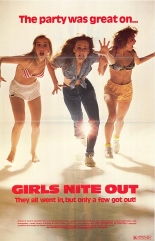
 How bad is the slasher movie suckfest that is Girls Nite Out? So bad that its very existence is a paradoxical phenomenon I have named the GNO Enigma. It works like this: The plot and characters of Girls Nite Out are so derivative that the film owes its entire creation to the filmmakers’ repeated viewings of Friday the 13th and National Lampoon’s Animal House, while at the same time, the film is so incompetently made that it actually becomes inconceivable that they have ever seen another movie, much less the ones they’re so transparently ripping off.
How bad is the slasher movie suckfest that is Girls Nite Out? So bad that its very existence is a paradoxical phenomenon I have named the GNO Enigma. It works like this: The plot and characters of Girls Nite Out are so derivative that the film owes its entire creation to the filmmakers’ repeated viewings of Friday the 13th and National Lampoon’s Animal House, while at the same time, the film is so incompetently made that it actually becomes inconceivable that they have ever seen another movie, much less the ones they’re so transparently ripping off.
Ignoring such traditional bad-slasher-movie features such as terrible acting, repellent characters and a script (written by four people!) that wastes a full third of its running time on a romantic subplot that is never resolved and has nothing to do with the actual story, Girls Nite Out shows a remarkable ability to fuck up on virtually every technical level.
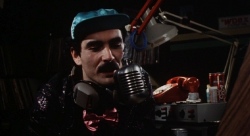 It would be impossible to list all of them in detail, but my favorite has to be the movie’s reliance on the only three songs its producers could afford to license. Imagine watching a movie where the entire soundtrack is comprised of Ohio Express’ “Yummy Yummy Yummy” and The Lovin’ Spoonful’s “Do You Believe In Magic” and “Summer in the City.” Now imagine that a significant part of the movie’s narrative depends on the characters listening to their campus radio station, whose hip, cool-daddy DJ plays only those three terrible songs!
It would be impossible to list all of them in detail, but my favorite has to be the movie’s reliance on the only three songs its producers could afford to license. Imagine watching a movie where the entire soundtrack is comprised of Ohio Express’ “Yummy Yummy Yummy” and The Lovin’ Spoonful’s “Do You Believe In Magic” and “Summer in the City.” Now imagine that a significant part of the movie’s narrative depends on the characters listening to their campus radio station, whose hip, cool-daddy DJ plays only those three terrible songs!
I’d summarize the plot, which involves a maniac killing college kids while dressed in an adorable bear mascot costume, but I refuse to spend more time thinking about it than the producers did. Don’t watch this movie. For the love of whatever deity you choose, do not watch this movie! —Allan Mott

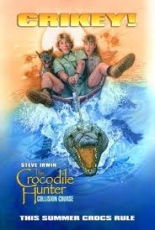
 In space, no one can hear you scream “Crikey!” But that’s where, in
In space, no one can hear you scream “Crikey!” But that’s where, in  The two “stories” converge briefly when the agents come upon the croc in Steve’s possession and he mistakes them for poachers, putting them all on a collision course … with laughter!
The two “stories” converge briefly when the agents come upon the croc in Steve’s possession and he mistakes them for poachers, putting them all on a collision course … with laughter!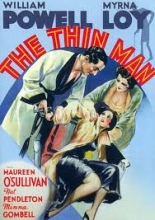
 When people talk about
When people talk about 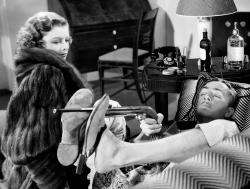 Nick finally gives in, but he’ll be damned if he’s going to sober up to solve this thing. There are lots of suspects and plenty of motives to sort through, but Nick negotiates them all with intelligence and charm without even having to set down his cocktail. He slurs and grins his way through the case all the way to the requisite, gather-all-the-suspects dinner party at the end. Nora mostly looks on with curiosity while making good-natured faces at her husband in this one, but she gets more to do in the five sequels that followed. —Michael May
Nick finally gives in, but he’ll be damned if he’s going to sober up to solve this thing. There are lots of suspects and plenty of motives to sort through, but Nick negotiates them all with intelligence and charm without even having to set down his cocktail. He slurs and grins his way through the case all the way to the requisite, gather-all-the-suspects dinner party at the end. Nora mostly looks on with curiosity while making good-natured faces at her husband in this one, but she gets more to do in the five sequels that followed. —Michael May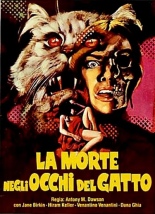
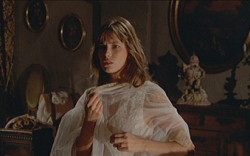 Must be true, because shortly thereafter, she discovers a rotting corpse in the castle’s underground tunnels, not to mention a caged gorilla. He’s the pet of Lord James (Hiram Keller), who’s possibly insane and rumored to have killed someone, and possibly even has the power to shape-shift. And every time the titular tabby shows up, someone gets killed, thereby putting the “ow” in “meow.”
Must be true, because shortly thereafter, she discovers a rotting corpse in the castle’s underground tunnels, not to mention a caged gorilla. He’s the pet of Lord James (Hiram Keller), who’s possibly insane and rumored to have killed someone, and possibly even has the power to shape-shift. And every time the titular tabby shows up, someone gets killed, thereby putting the “ow” in “meow.” 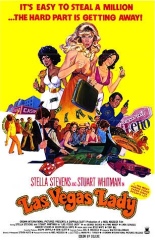

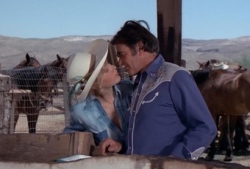 It’s a not-so-ritzy joint where the entertainment isn’t Goth magicians, killer tigers or stick-up-the-ass Billboard divas, but a chintzy circus act starring three busty trapeze artists, one of whom is sick of all the flying around. Lucky corrals her (Linda Scruggs) and a token black woman (Lynne Moody,
It’s a not-so-ritzy joint where the entertainment isn’t Goth magicians, killer tigers or stick-up-the-ass Billboard divas, but a chintzy circus act starring three busty trapeze artists, one of whom is sick of all the flying around. Lucky corrals her (Linda Scruggs) and a token black woman (Lynne Moody,